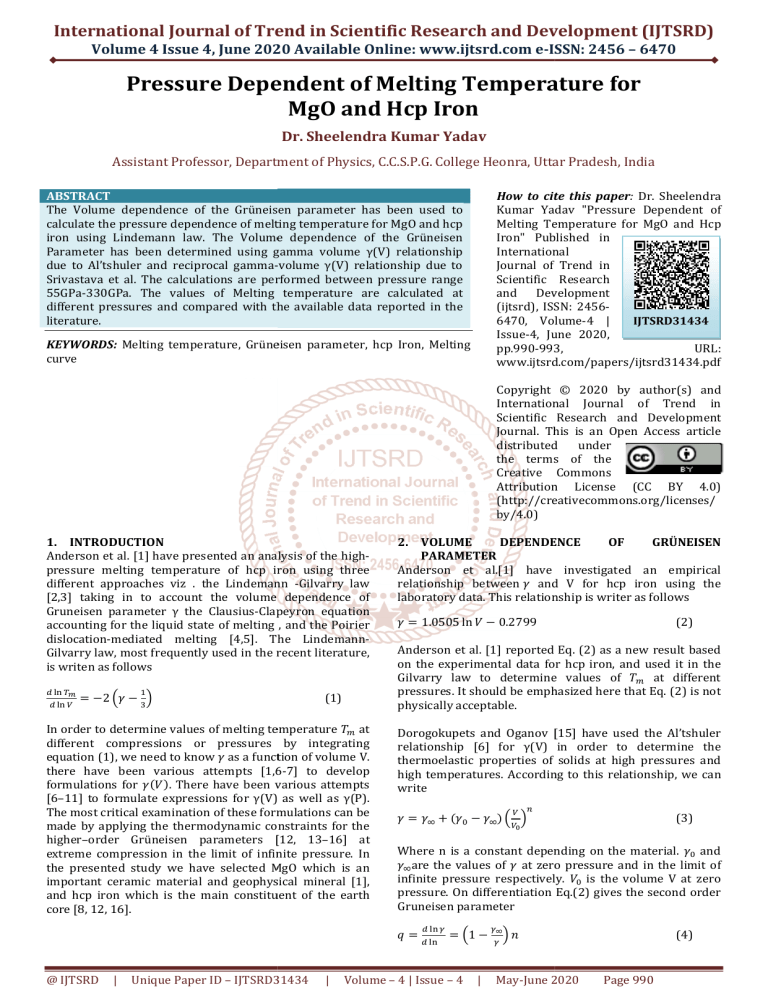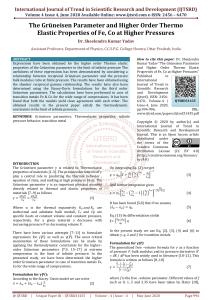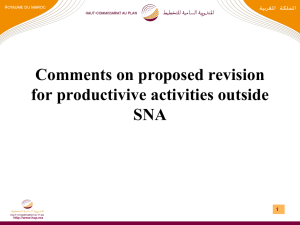
International Journal of Trend in Scientific Research and Development (IJTSRD) Volume 4 Issue 4, June 2020 Available Online: www.ijtsrd.com e-ISSN: ISSN: 2456 – 6470 Pressure Dependent of Melting Temperature for MgO and Hcp Iron Dr. Sheelendra Kumar Yadav Assistant Professor, Department of Physics, C.C.S.P.G. College Heonra, Uttar Pradesh, India ABSTRACT The Volume dependence of the Grüneisen parameter has been used to calculate the pressure dependence of melting temperature for MgO and hcp iron using Lindemann law. The Volume dependence of the Grüneisen Parameter has been determined using gamma volume γ(V) relationship due to Al’tshuler and reciprocal gamma--volume γ(V) relationship due to Srivastava et al. The calculations are performed between pressure range 55GPa-330GPa. 330GPa. The values of Melting temperature are calculated at different pressures and compared with the available data reported in th the literature. How to cite this paper: paper Dr. Sheelendra Kumar Yadav "Pressure Dependent of Melting Temperature for MgO and Hcp Iron" Published in International Journal of Trend in Scientific Research and Development (ijtsrd), ISSN: 24562456 6470, Volume-4 Volume | IJTSRD31434 Issue-4, 4, June 2020, pp.990-993, 993, URL: www.ijtsrd.com/papers/ijtsrd31434.pdf KEYWORDS: Melting temperature, Grüneisen parameter, hcp Iron, Melting curve Copyright © 2020 by author(s) and International Journal of Trend in Scientific Research and Development Journal. This is an Open Access article distributed under the terms of the Creative Commons Attribution License (CC BY 4.0) (http://creativecommons. (http://creativecommons.org/licenses/ by/4.0) 1. INTRODUCTION Anderson et al. [1] have presented an analysis of the high highpressure melting temperature of hcp iron using three different approaches viz . the Lindemann -Gilvarry law [2,3] taking in to o account the volume dependence of Gruneisen parameter γ the Clausius-Clapeyron Clapeyron equation accounting for the liquid state of melting , and the Poirier dislocation-mediated mediated melting [4,5]. The Lindemann LindemannGilvarry law, most frequently used in the recent litera literature, is writen as follows = −2 𝛾 − (1) In order to determine values of melting temperature 𝑇 at different compressions or pressures by integrating equation (1), we need to know 𝛾 as a function of volume V. there have been various attempts [1,6 [1,6-7] to develop formulations for 𝛾(𝑉). There have been various attempts [6–11] to formulate expressions for γ(V) (V) as well as γ(P). The most critical examination of these formulations can be madee by applying the thermodynamic constraints for the higher–order order Grüneisen parameters [12, 13 13–16] at extreme compression in the limit of infinite pressure. In the presented study we have selected MgO which is an important ceramic material and geophysical m mineral [1], and hcp iron which is the main constituent of the earth core [8, 12, 16]. 2. VOLUME DEPENDENCE OF GRÜNEISEN PARAMETER Anderson et al.[1] have investigated an empirical relationship between 𝛾 and V for hcp iron using the laboratory data. This relationship is writer as follows Anderson et al. [1] reported Eq. (2) as a new result based on the experimental data for hcp iron, and used it in the Gilvarry law to determine values of 𝑇 at different pressures. It should be emphasized here that Eq. (2) is not physically acceptable. Dorogokupets and Oganov [15] have used the Al’tshuler relationship [6] for γ(V) (V) in order to determine the thermoelastic properties of solids at high pressures pressure and high temperatures. According to this relationship, we can write | Unique Paper ID – IJTSRD31434 | (3) 𝛾 = 𝛾∞ + (𝛾 − 𝛾∞ ) Where n is a constant depending on the material. 𝛾 and 𝛾∞ are the values of 𝛾 at zero pressure and in the limit of infinite pressure respectively. 𝑉 is the volume V at zero pressure. On differentiation Eq.(2) gives the second order Gruneisen parameter 𝑞= @ IJTSRD (2) 𝛾 = 1.0505 ln 𝑉 − 0.2799 = 1− Volume – 4 | Issue – 4 | ∞ (4) 𝑛 May-June June 2020 Page 990 International Journal of Trend in Scientific Research and Development (IJTSRD) @ www.ijtsrd.com eISSN: 2456-6470 And further differentiation yields the following expression for the third order Grüneisen parameter 𝜆= = ∞ (5) Eq. (4) reveals that 𝑞∞ tends to zero when 𝛾 tends to 𝛾∞ . This is consistent with the thermodynamic constraint [2,3,13]. In the limit of infinite pressure, Eq. (5) gives 𝜆∞ = 𝑛 (6) And therefore 𝜆𝛾 =𝜆∞ 𝛾∞ = constant (7) In order to rectify this shortcoming, attempts have been made to use the following expression for reciprocal gamma [17-11] ∞ + − (8) ∞ Eq. (8) on successive differentiation yields 𝑞= =𝑛 ∞ (9) −1 ∞ = ∞ = constant (11) Eq.(11) 11) is consistent with the finding that λ and γ both decrease with the increase in pressure. For determining values of the third order Grnüeisen parameter λ at limit of infinite pressures in case of the earth lower mantle and core, Stacey and Davis [2] scaled to .This is an ∞ ∞ agreement with Eq. (11). A more critical test of an expression for γ (V)) can be provide using the definition of the fourth order Grüneisen parameter ξ given below [16] ξ= 𝛾=𝛾 ∞ − ∞ ∞ −1 ∞ (16) (17) Then Eq. (16) reduces to Eq. (8), and Eq. (14) becomes compatible with Eq. (9) to (11). Eq. (17) is not satisfied by the available data [2, 16]. Eq. (14) on differentiation yields ∞ ξ= 𝑞 (18) In the present study we use Eq. (14), (15), (16) and (18) to obtain γ, q, 𝜆 and ξ for MgO and hcp iron. 3. LINDEMANN LAW OF MELTING Lindemann law is represented by Eq. (1). We prefer Eq. (8) over Eq. (14) to be used in Eq. (1) because Eq. (8) can be integrated analytically to obtain values of 𝑇 at different compressions. It is difficult to integrate Eq. (14) (14 using analytical methods. Eq. (1) and (8) taken together yield on integration ∞ ∞ ∞ (19) We have used eq. (19) to determine values of 𝑇 (𝑉). The results are then obtained for 𝑇 (𝑃) using the pressurevolume relationship for hcp iron[9] based on the seismic data [8]. 4. RESULTS AND DISCUSSIONS For hcp iron, we take 𝛾 = 1.83, 1 𝛾∞ = 1.33, 𝐾 ′ = 5.0 , 𝑞 = 1.18 from Stacey and Davis [8]. In Eq. (13), 𝑇 , 𝑉 and 𝛾 correspond to the reference or the starting point. For hcp iron the starting point is at about 55GPa and 𝑇 = 𝑇 (55𝐺𝑃𝑎) = 2790𝐾 [1]. Data have been used to obtain V(P)/V(55GPa) with the help of the Stacey reciprocal KK primed EOS[8,9]. We use the Stacey K-primed primed equation of state, which is based on Eq. (12) Eq. (11) and (12) yield = ∞ (20) ∙ ∞ (13) According to Eq. (13) the fourth order Grüneisen parameter ξ is equal to the second order Grüneisen parameter q.. This result based on Eq. (8) is not consistent with the results for ξ and q recently reported by Shanker et al. [16]. It should be emphasized that Eq. (8) is a simplified version [18, 11] of the Stacey Stacey- Davis formulation [2] for γ(V). ). According to the Stacey Stacey- Davis model we can write 𝜆 = 𝜆∞ + (𝜆 − 𝜆∞ ) (14) @ IJTSRD | Unique Paper ID – IJTSRD31434 = And can be written as follows; ∙ | (15) ∞ (10) ∞ Eq. (9) is consistent with the constraints that 𝑞∞ tends to zero when 𝛾 tends to 𝛾∞ Eq. (10) gives 𝜆∞ = 𝑛 and ∞ − And further integration gives = and 𝜆= = ∞ 𝑞 =𝑞 1+ It has been found [18, 11] that if we assume 𝜆 − 𝜆∞ = 𝑞 It has been found [2,3,13-16] that 𝜆 𝑎𝑛𝑑 𝛾 both decrease with the increase in pressure. However, Eq.(7) which is based on Eq. (2) is in contradiction to this finding according to Eq. (7), 𝜆 must increase with P when 𝛾 decreases. Thus it comes evident nt that Eq. (2) is not valid. = On integrating Eq. (13),we get = ∙ ∙ ∞ ∙ + 1− (21) On integration , Eq. (21) gives ∙⁄ ∙ ∞ = 1 − 𝐾∞∙ (22) Further integration of Eq. (23) gives ln = ∙ ∙ ∞ Volume – 4 | Issue – 4 −1 | + ∙ , ∞ ln 1 − 𝐾∞∙ May-June June 2020 2 Page 991 (23) International Journal of Trend in Scientific Research and Development (IJTSRD) @ www.ijtsrd.com eISSN: 2456-6470 Table (1) values of volume compression V(P)/V(55GPa) at different pressures for hcp iron based on the seismic data and the Stacey equation of state [8,9], Grüneisen parameter γ calculated from Eq. (3) at n=3.66 and from Eq. (8) at n=3.14 and 2.66. P(GPa) 55.0 68.8 80.5 100.0 V(P)/V(55GPa) 1 0.9686 0.9452 0.9117 γEq.(3) 1.571 1.544 1.526 1.502 γEq.(7) 1.557 1.532 1.515 1.493 3892 4196 4551 4971 5240 5736 131.1 155.6 186.0 224.2 250.0 300.0 0.8679 0.8394 0.8092 0.7774 0.7587 0.7275 1.473 1.457 1.441 1.426 1.418 1.405 1.467 1.452 1.438 1.424 1.417 1.406 Melting Temperature Tm (K) Tm 2790 3014 3195 3476 P (GPa) 5. CONCLUSION The results for 𝑇 at different pressures and compressions are given Table. Values of 𝑇 for Mgo and hcp iron determined from Eqs. (14) and (15) are in good agreement with those obtained from the Stacey ––Irvin model [8] based on the fundamental thermodynamics [1]. The most important conclusion is that the Lindemann Lindemann-Gilvarry law of melting is valid for hcp iron and consistent with the thermodynamic constraints for the volume dependence of the Grüneisen parameter at extreme compression. At 330 GPa, the pressure for the Earth inner core core-outer core boundary, the melting temperature for hcp iro iron is very close to 6000K. The importance of infinite pressure or extreme compression behavior of materials has been discussed in details by Stacey and Davis [8] pointing out the usefulness of infinite pressure constraints in determining the properties at finite inite pressures. Values of γ, q, 𝜆 and ξ at and hcp iron calculated from the two formulations compare with each other. @ IJTSRD | Unique Paper ID – IJTSRD31434 | ACKNOWLEDGEMENTS We are thankful to the reviewers for their helpful comments. Thanks are also due to Professor Anuj Vijay & Professor J. Shanker, for some very useful discussions. REFERENCE [1] O. L. Anderson, D. G. Isaak, and V. E. Nelson, J. Phys. Chem. Solids 64 (2003) 2125-2131. 2125 [2] F. A. Lindemann, Phys. Z 11(1910)609. [3] J. J. Gilvarry, Phys. Rev. 102(1956)308. [4] Poirier J.P., Geophys.J.R. Astron.Soc. Ast 85 (1986) 315. [5] J. P. Poirier, Shankland T. J., in: S. C. Schmidt, J.W. Shaner, G. A. Samara, and M.Ross(Eds), High Pressure Science and Technology-1993American Technology Institute of Physics, Woodbury, N Y(1994) 927. Volume – 4 | Issue – 4 | May-June June 2020 2 Page 992 International Journal of Trend in Scientific Research and Development (IJTSRD) @ www.ijtsrd.com eISSN: 2456-6470 [6] L. V. At’shuler, S. E. Brusnikin and E. A. Kuz’menkov, J. Appl. Mech. Tech. Phys. 28, (1987) 129 129-141 [15] P. I. Dorogokupets, and R. A. Oganov, Phys. Rev. B 75(2007)24115. [7] S. S. Kushwah, Y. S. Tomar, and M.P. Sharma, High Temp.-High Press. 41 (2012) 309. [16] J. Shanker, K. Sunil, and B. S. Sharma Phys. Earth Planet. Int. 262, (2017)41. [8] F. D. Stacey, and P.M. Davis, Phys. Earth Planet. Inter. 142 (2004) 137. [17] S. K. Srivastava, P. Sinha, and N. Verma, High Temp.High Press. 40 (2011)169. [9] A. Vijay, Physica B 391, (2007) 157. [18] J. Shanker, B. P. Singh and H K Baghel, PhysicaB 387 (2007)409 [10] F. D. Stacey, and R.D. Irvine, Aust. J. Phys. 30 (1977)631. [11] A. Vijay, High Temperatures-High High Pressures 43 (2014)47. [12] F. D. Stacey Rep. Prog. Phys. 68, (2005) 341 [13] J. Shanker, P. Dulari and P.K. Singh, Physica B 404 (2009) 4083. [19] K. Sheelendra & A. Vijay,Journal of Physics and Chemistry of Solids.123 (2018) 364364 370. [20] K. Sheelendra & A. Vijay, High Temperatures-High Pressures,, Vol. 47, pp. 193–204. 193 [21] K. Sheelendra & A. Vijay, 9th National Conference on Thermo physical Properties (NCTP-2017) (NCTP 030001-1– 030001-5. [14] J. Shanker,, B. P. Singh, and S.K. Srivastava, Phys. Earth Planet. Inter.147 (2004) 333. @ IJTSRD | Unique Paper ID – IJTSRD31434 | Volume – 4 | Issue – 4 | May-June June 2020 2 Page 993





